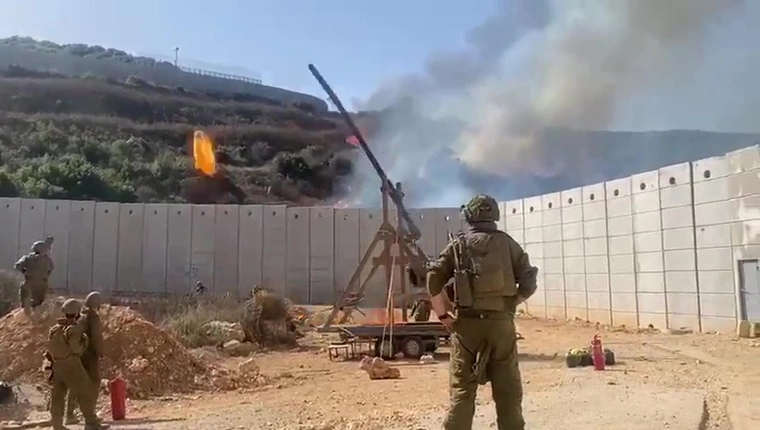In a surprising display of ancient technology in modern warfare, the Israeli Defense Forces (IDF) have turned to a medieval siege weapon, the trebuchet, to combat Hezbollah fighters along its northern border with Lebanon.
The unconventional approach went viral after video footage surfaced on social media Thursday of IDF soldiers using the ancient catapult to hurl flaming projectiles across the Lebanese border.
The IDF confirmed the authenticity of the footage, clarifying that this was not a widespread military tactic but rather a local initiative by soldiers stationed near the Lebanon border.
In an era dominated by high-tech weaponry, the sight of a trebuchet used by modern soldiers seems conspicuously archaic. However, the IDF hinted that the weapon’s use was a unique response to terrain challenges in the area.
“This is a local initiative and not a tool that has come into widespread use,” the IDF said in a statement to Israeli state broadcaster KAN news. “The area on the Lebanese border is characterized by boulders, thickets, and dense thorn vegetation, which poses a challenge to the IDF forces deployed in defense.”
The trebuchet, a catapult designed to hurl heavy projectiles over great distances, was a mainstay of siege warfare throughout the Middle Ages.
Originating in China in the 4th century BCE, the trebuchet made its way to Europe by the 12th century AD and played an instrumental role in numerous historical sieges, including the Siege of Acre during the Third Crusade and the Hundred Years’ War between England and France.
The earliest devices, called traction trebuchets or mangonels, were operated by soldiers pulling cords attached to a lever and sling to hurl projectiles at enemy forces. Traction trebuchets, representing the earliest form of artillery, were widely used for nearly 1,000 years by warring armies in ancient China and across Eurasia.
By the 12th century AD, the trebuchet had been updated to a larger and more powerful counterweight design. Instead of relying on manpower, this version used a heavy counterweight, typically a box filled with stones or sand. The counterweight leveraged gravity to launch projectiles with much greater force and distance than the earlier traction trebuchet.
During its heyday, a typical trebuchet projectile could be almost anything, including incendiary bombs, large stones, or, in the case of the Mongols in 1346, the rotting corpses of plague victims.
The use of the trebuchet tapered off by the 15th century with the advent of gunpowder, which allowed for the development of more advanced and powerful artillery.
In the footage circulating on social media, IDF troops can be seen using the updated counterweight trebuchet design to launch a flaming object high into the air and over the border wall.
While the IDF has not officially confirmed the strategic rationale behind this medieval approach, it is likely the military is employing the ancient siege weapon to launch incendiary projectiles to set nearby vegetation ablaze.
The rugged terrain along the Lebanese border contains numerous boulders, dense thickets, and thorny vegetation. These natural obstacles provide ideal cover for Hezbollah fighters, posing a significant challenge for IDF troops to secure the border and spot potential threats.
Using a trebuchet to clear vegetation is a pragmatic, albeit unconventional, solution to this problem. By setting fire to the dense foliage, the IDF can expose potential hiding spots for Hezbollah fighters, making it easier to identify and counteract threats.
Modern artillery and munitions are valuable and sometimes scarce resources. Using a trebuchet, IDF soldiers can clear large areas of dense vegetation without expending precious artillery rounds, preserving them for more critical engagements.
Additionally, using an ancient weapon like the trebuchet poses much less risk of public outcry compared to modern incendiary munitions such as napalm.
Ultimately, while surprising, the IDF’s decision to employ a trebuchet highlights the resourcefulness and adaptability of military forces in challenging situations.
This medieval tactic also underscores the enduring relevance of historical military techniques. Despite the technological advancements in modern warfare, certain conditions and environments may still call for time-tested methods.
IDF forces’ use of a trebuchet is a stark reminder that in war, necessity often drives innovation, sometimes in the most unexpected ways.
Tim McMillan is a retired law enforcement executive, investigative reporter and co-founder of The Debrief. His writing typically focuses on defense, national security, the Intelligence Community and topics related to psychology. You can follow Tim on Twitter: @LtTimMcMillan. Tim can be reached by email: tim@thedebrief.org or through encrypted email: LtTimMcMillan@protonmail.com

